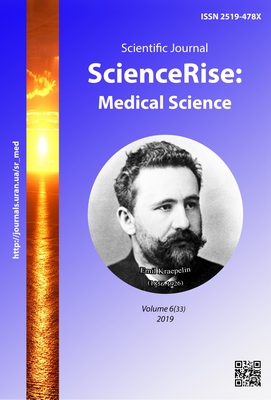Ретроспективна оцінка впливу тривалого застосування інгаляційних глюкокортикостероїдів на фізичний розвиток хворих на бронхіальну астму дітей та підлітків
DOI:
https://doi.org/10.15587/2519-4798.2019.185635Ключові слова:
бронхіальна астма, діти, інгаляційні глюкокортикостероїди, фізичний розвиток, ретроспективний аналізАнотація
Метою нашої роботи було оцінити ретроспективно дозозалежний вплив інгаляційних стероїдів на антропометричні показники хворих на бронхіальну астму дітей і підлітків.
Матеріали та методи. На базі пульмонологічного відділення Обласної дитячої клінічної лікарні м. Чернівці проведена оцінка фізичного розвитку 50 хворих на бронхіальну астму дітей, які тривало застосовують інгаляційні глюкокортикостероїди (ІГКС).
Усім пацієнтам проводили антропометрічне дослідження: вимірювання ваги та зросту з обчисленням індексу маси тіла (ІМТ). Оцінку фізичного розвитку пацієнтів проводили за центильним методом із урахуванням віку пацієнтів (із використанням центильних таблиць «антропометричний показник до віку»).
Результати. Показник зросту у перцентилях відносно віку пацієнтів становив, у середньому, 50±4,4, що відповідає середній віковій нормі. При цьому зріст нижче середнього (10-25 перцентилей) відносно віку зареєстровано у 12 % пацієнтів, а низький (5-10 перцентилей) або дуже низький зріст (<5 перцентилей) відмічалися лише у 4 пацієнтів (6 % та 2 % осіб відповідно). Водночас встановлено, що середній показник ІМТ в обстежених хворих становив 20,4±0,5 кг/м2, що відповідає нормостенічній тілобудові. Слід відмітити, що зайва вага (ІМТ> 25 кг/м2) відмічалася лише у 5 обстежених хворих (10 %), з яких лише у однієї особи (2 %) відмічалося клінічно значуще (ІМТ> 30 кг/м2) ожиріння.
Висновки. З позиції доказової медицини, не доведено негативного впливу тривалого застосування ІГКС, у т.ч. в середньо-високих або високих дозах, на зріст та масу тіла хворих на БА дітей та підлітків. При цьому, не знайдено статистично значущих даних щодо асоціації ожиріння та низкорослості із пролонгованим застосуванням середньо-високих або високих доз ІГКС: атрибутивний ризик надлишкової (ІМТ>25 кг/м2) маси тіла становив 24 % при співвідношенні шансів =3,2 (95 % довірчий інтервал: 0,33-30,94) та атрибутивний ризик виникнення низкорослості (зріст <10 перцентилей): становив 18 %, а співвідношенні шансів =2,3 (95 % довірчий інтервал: 0,22-23,88)
Посилання
- Subbarao, P., Mandhane, P. J., Sears, M. R. (2009). Asthma: epidemiology, etiology and risk factors. Canadian Medical Association Journal, 181 (9), 181–190. doi: http://doi.org/10.1503/cmaj.080612
- Löwhagen, O. (2012). Diagnosis of asthma - a new approach. Allergy, 67 (6), 713–717. doi: http://doi.org/10.1111/j.1398-9995.2012.02821.x
- Stanford, R. H., Gilsenan, A. W., Ziemiecki, R., Zhou, X., Lincourt, W. R., Ortega, H. (2010). Predictors of Uncontrolled Asthma in Adult and Pediatric Patients: Analysis of the Asthma Control Characteristics and Prevalence Survey Studies (ACCESS). Journal of Asthma, 47 (3), 257–262. doi: http://doi.org/10.3109/02770900903584019
- Lindsay, J. T., Heaney, L. G. (2013). Nonadherence in difficult asthma – facts, myths, and a time to act. Patient Preference and Adherence, 7, 329–336. doi: http://doi.org/10.2147/ppa.s38208
- Pocket Guide for Asthma Management and Prevention (2015). Global Initiative for Asthma. Available at: http://ginasthma.org/wp-content/uploads/2016/01/GINA_Pocket_2015.pdf
- Bezrukov, L. O., Koloskova, O. K., Ivanova, L. A., Vorotniak, T. M., Ortemenka, Ye. P., Shakhova, O. O. (2011). Vybrani pytannia diahnostyky ta likuvannia bronkhialnoi astmy v ditei. Chernivtsi: Vydavnycho-informatsiinyi tsentr „Misto”, 248.
- Mäkelä, M. J., Backer, V., Hedegaard, M., Larsson, K. (2013). Adherence to inhaled therapies, health outcomes and costs in patients with asthma and COPD. Respiratory Medicine, 107 (10), 1481–1490. doi: http://doi.org/10.1016/j.rmed.2013.04.005
- Pandya, D., Puttanna, A., Balagopal, V. (2014). Systemic Effects of Inhaled Corticosteroids: An Overview. The Open Respiratory Medicine Journal, 8 (1), 59–65. doi: http://doi.org/10.2174/1874306401408010059
- Philip, J. (2014). The Effects of Inhaled Corticosteroids on Growth in Children. The Open Respiratory Medicine Journal, 8 (1), 66–73. doi: http://doi.org/10.2174/1874306401408010066
- Marchac, V., Foussier, V., Devillier, P., Le Bourgeois, M., Polak, M. (2007). Fluticasone propionate in children and infants with asthma. Archives de Pédiatrie, 14 (4), 376–387. doi: http://doi.org/10.1016/j.arcped.2006.11.026
- Kostic, G., Ilic, N., Petrovic, M., Markovic, S., Vuletic, B., Igrutinovic, Z. (2010). Body mass index in asthmatic children before and after one year inhaled glucocorticosteroids therapy BMI. Medicinski Pregled, 63 (5-6), 409–413. doi: http://doi.org/10.2298/mpns1006409k
- Unifikovanyi klinichnyi protokol pervynnoi, vtorynnoi (spetsializovanoi) dopomohy pry bronkhilnii astmi u ditei (2013). Nakaz MOZ Ukrainy No. 868. 08.10.2013. Available at: http://mtd.dec.gov.ua/images/dodatki/2013_868BA_dor_dit/2013_868_ykpmd_BA_dity.pdf
- Holgate, S. T., Polosa, R. (2008). Treatment strategies for allergy and asthma. Nature Reviews Immunology, 8 (3), 218–230. doi: http://doi.org/10.1038/nri2262
- Fuhlbrigge, A. L., & Kelly, H. W. (2014). Inhaled corticosteroids in children: effects on bone mineral density and growth. The Lancet Respiratory Medicine, 2(6), 487–496. doi: http://doi.org/10.1016/s2213-2600(14)70024-4
- Hossny, E., Rosario, N., Lee, B. W., Singh, M., El-Ghoneimy, D., SOH, J. Y., Le Souef, P. (2016). The use of inhaled corticosteroids in pediatric asthma: update. World Allergy Organization Journal, 9, 26. doi: http://doi.org/10.1186/s40413-016-0117-0
##submission.downloads##
Опубліковано
Як цитувати
Номер
Розділ
Ліцензія
Авторське право (c) 2019 Kristina Burynyuk-Gloviak, Yevheniya Ortemenka

Ця робота ліцензується відповідно до Creative Commons Attribution 4.0 International License.
Наше видання використовує положення про авторські права Creative Commons CC BY для журналів відкритого доступу.
Автори, які публікуються у цьому журналі, погоджуються з наступними умовами:
1. Автори залишають за собою право на авторство своєї роботи та передають журналу право першої публікації цієї роботи на умовах ліцензії Creative Commons CC BY, котра дозволяє іншим особам вільно розповсюджувати опубліковану роботу з обов'язковим посиланням на авторів оригінальної роботи та першу публікацію роботи у цьому журналі.
2. Автори мають право укладати самостійні додаткові угоди щодо неексклюзивного розповсюдження роботи у тому вигляді, в якому вона була опублікована цим журналом (наприклад, розміщувати роботу в електронному сховищі установи або публікувати у складі монографії), за умови збереження посилання на першу публікацію роботи у цьому журналі.










